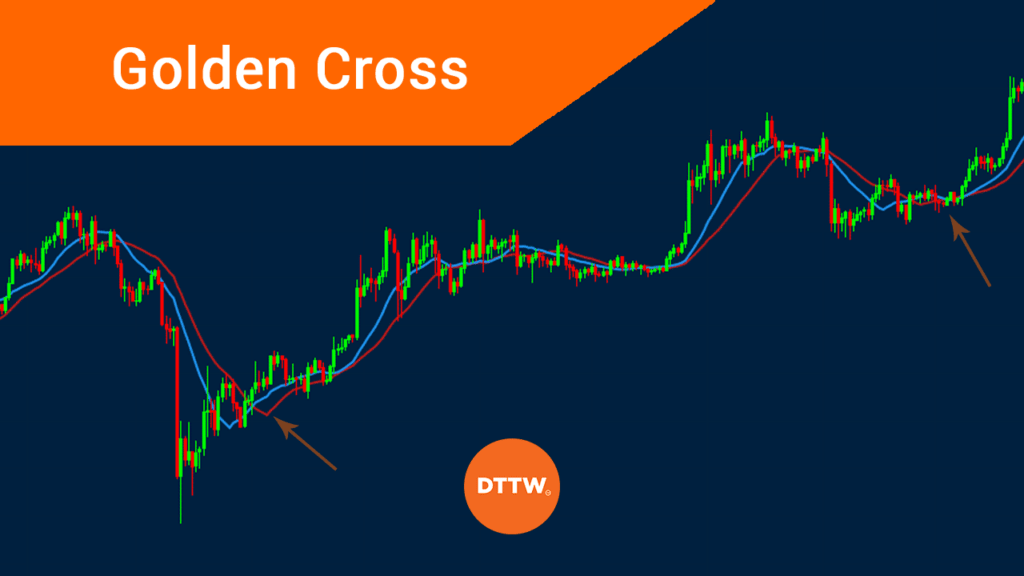Moving averages are the most popular indicators among traders and investors. They are so popular that they have been used to build other indicators like Bollinger Bands, Keltner Channels, and the MACD.
Traders use moving averages in various ways. For example, some use it in trend-following while others use it in reversals. The indicators can also be used to find support and resistance levels.
In this article, we will look at the concept of a golden cross, which is a popular approach used by traders and investors.
Table of Contents
What is golden cross in trading?
This is a bullish signal that emerges when two moving averages make a crossover. The most common periods of the two moving averages are 50-day and 200-day moving averages.
Also, the strategy mostly uses the simple moving average indicator but some traders focus on the exponential, smoothed, and weighted moving averages.
The idea behind the golden cross is very simple. When the asset price starts to rise, it first meets the 50-day moving average. This happens as buyers start pushing the price higher with some staying in the side-lines.
Then, when the price manages to move above the 200 moving average, more buyers get convinced that this is, indeed, a bull run and then continue pushing the price higher.
A golden cross tells a trader several things. First, this tool tell them that an asset that was in a downward trend could be bottoming. Second, a golden cross is a sign that buyers are coming into the market. Third, and most importantly, it is a sign that sentiment in the market is improving.
Better periods for day traders
However, since the 50-day and 200-day moving averages are relatively wide for day traders, most of them have narrowed down the periods. Some will combine the 10 and 50-period moving averages while others will combine the 25-period and 50-period MAs.
Golden cross can be used in all types of financial assets, including currencies, stocks, indices, commodities, and exchange-traded funds (ETFs).
Golden cross vs death cross
The opposite of the golden cross is the death cross. It refers to a period when the shorter moving average (50 MA) moves below the 200-day MAs.
It starts after a bullish trend when the price moves below the shorter MA, in a signal that bears are returning. This is then followed by another cross of the longer MA. In most cases, this usually leads to a further decline of the asset price.
How golden cross forms
To understand how the cross forms, you first need to understand the concept of moving averages. A moving average is a technical indicator that is calculated by finding the average prices of an asset’s price.
There are several types of moving averages, including simple MA, exponential MA, weighted MA, and the smoothed MA. All of these are based on the same concept but have different formulas because of the need to remove or reduce the lag found in simple moving averages.
For example, the exponential MA removes the lag by providing more weighting to recent prices while the WMA removes this lag by diluting the impact of early data.
The golden cross starts after a long period of downward trend in the price of an asset. As it starts to rebound, the price then moves above the shorter-time moving average and then moves to the longer-term average.
Example of a golden cross
On the daily chart below, we see that the price of Bitcoin continued to soar after moving above the 50-day and 200-day moving averages.
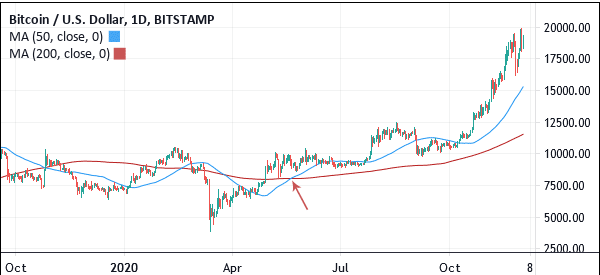
On the chart below, we have used a 15-day and 25-day moving average, which is a popular combination among day traders.
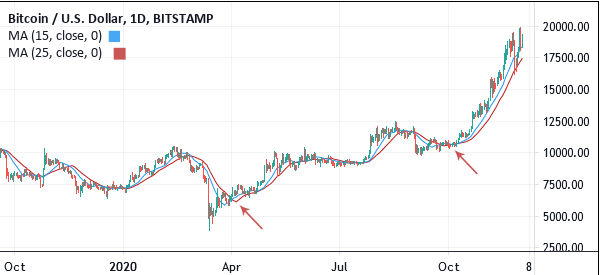
Golden cross trading strategies
There are several approaches to using the golden cross pattern. Let us look at some of them.
First, you can combine the golden cross pattern with chart patterns. Some of the most popular patterns you can use are inverted head and shoulders, inverted cup and handle, double-bottom, and triple-bottom.
When these patterns form, you can confirm their bullish view by waiting for the golden cross to confirm the bullish view.
For example, the golden cross pattern below happened after Google shares formed a triple-bottom pattern whose neckline was at $108.885.
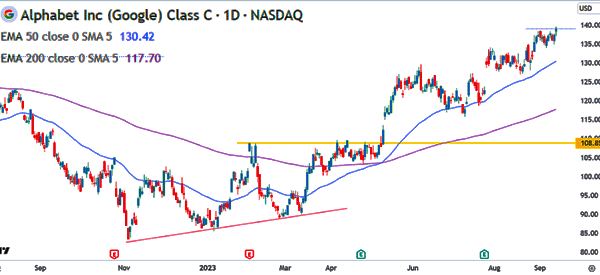
Second, the other strategy is to use the 50-day moving average as the key support after implementing a trade. In this case, you should always exit the trade if it moves below that moving average.
Third, the other approach is to use the golden cross with other tools. Some of the most popular tools you can use are the Fibonacci Retracement and Andrews Pitchfork.
Golden cross limitations and false signals
Like other strategies, golden crosses have their limitations. First, at times, the formation of a golden cross is not always a guarantee that an asset will continue rising. At times, a golden cross pattern can be followed by a dive, as shown below.
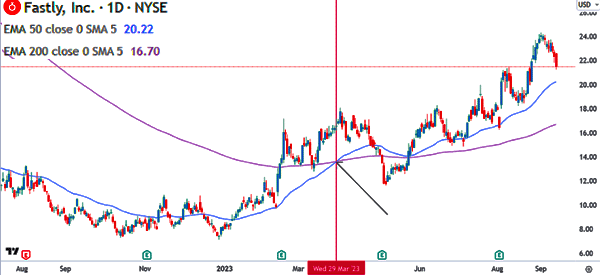
Second, since the real definition of a golden cross is when the 200-day and 50-day moving averages crossover, many day traders cannot use it. Most day traders use extremely short timeframes like 5-minute or 1-minute. As such, applying a 200-period and 50-period moving averages will often produce false signals.
Third, a golden cross uses moving averages, which are lagging indicators. As such, it does not consider in important factors like earnings and monetary policy.
For example, a golden cross that happens before earnings can lead to a false signal if a company publishes weak financial results.
Risk management when using golden cross
Risk management is an important concept in day trading and investment. Its goal is to maximize profit returns while minimizing risks. Day traders should always use risk management strategies regardless of their trading strategy.
First, you should be patient before executing your trade. A common mistake is where people place a buy trade when a golden cross pattern forms. Waiting will give you a chance to analyze the trend and initiate a trade.
Second, you should use a trailing stop when you place a buy trade. This is a unique type of a stop-loss that moves with an asset. As such, it will capture your profits even when the asset price retreats.
Third, it is always important to look at other things in the market. In this, in addition to looking at the golden cross, you should look at the news and events that will affect the asset price.
Other risk management approaches are position sizing and ensuring that you are not over-leveraged. Also, you should consider always using arbitrage to limit your downside.
Golden cross FAQs
Is the golden cross reliable?
Yes. When used well, the golden cross can be a good and reliable trading strategy to use. However, for most day traders, the standard 200 and 50 crossover will not work out well. As such, you need to find your ideal sweet spot. You could select 14-7 or 25-15.
What does a golden cross indicate?
The golden cross indicates that buyers are coming back to the market. In most cases, it is a sign that the bullish trend will go on for a while.
Can you use the golden cross for all assets?
Yes. The golden cross indicator works for all assets, including bonds, stocks, and cryptocurrencies. In all these assets, you need to create your ideal golden cross trading strategy.
Summary
A golden cross is an important trading strategy that uses a combination of longer and shorter moving averages.
Like all trading strategies, it has its challenges. For example, for day traders, using the 200-day and 50-day moving averages tends to be less effective. Therefore, we recommend that you experiment on several time combinations to see the one that works well for you.
External Useful Resources
- 3 Simple Ways to Trade the Golden Cross – Tradingsim



